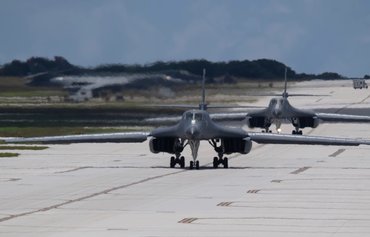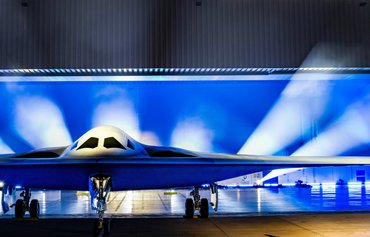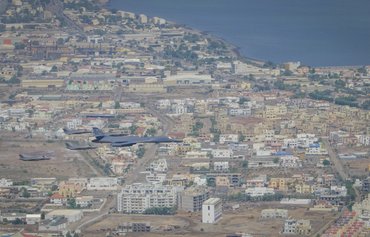The B-1B Lancer's speed, superior handling and huge payload allow it to seamlessly integrate in mixed force packages and make it a key element of any joint strike force.
It features a blended wing/body configuration, variable-geometry wings and turbofan afterburning engines that combine to provide long range, manoeuvrability and high speed while enhancing survivability, according to a US Air Force fact sheet.
Equipped with four General Electric F101-GE-102 turbofan engines, the Lancer can carry a payload of 75,000lb (34,019kg) and reach a max speed of 900-plus mph (>1,448km per hour or Mach 1.2 at sea level).
It can carry up to 84 500lb Mk-82 or 24 2,000lb Mk-84 general purpose bombs; 24 2,000lb GBU-31 or 15 500lb GBU-38 Joint Direct Attack Munitions (JDAMS); or 24 AGM-158A Joint Air-to-Surface Standoff Missiles (JASSMs), among other munitions.
![B1-B Lancers are escorted by coalition fighters over al-Udeid air base in Qatar during a Bomber Task Force mission on June 8. [CENTCOM]](/cnmi_am/images/2023/06/15/42538-b1b-600_384.jpg)
B1-B Lancers are escorted by coalition fighters over al-Udeid air base in Qatar during a Bomber Task Force mission on June 8. [CENTCOM]
![A B-1B Lancer approaches a refuelling aircraft during a Bomber Task Force mission above Saudi Arabia on June 8. [CENTCOM]](/cnmi_am/images/2023/06/15/42524-7845889-600_384.jpg)
A B-1B Lancer approaches a refuelling aircraft during a Bomber Task Force mission above Saudi Arabia on June 8. [CENTCOM]
Since 2019, the Air Force has also explored incorporating four to eight new hypersonic weapons by shifting the bulkhead and enabling the loading of a Conventional Rotary Launcher, the same system used inside the B-52, onto the B-1.
The Air Force is also testing the Load Adaptable Modular (LAM) pylon developed by Boeing that could boost the B-1B's conventional guided and unguided munitions capacity by up to 50%.
The B-1B holds almost 50 world records for speed, payload, range and time of climb in its class, according to the US Air Force.
The Lancer first saw combat against Iraq during Operation Desert Fox in December 1998.
During the first six months of Operation Enduring Freedom, which began in October 2001, eight B-1s dropped almost 40% of the total tonnage delivered by coalition air forces, the Air Force noted.
That figure included almost 3,900 JDAMs, or 67% of the total.
In Operation Iraqi Freedom, the B-1B flew less than 1% of the combat missions while delivering 43% of the JDAMs used.
The B-1's design and sensors allow it to carry out surprise attacks on enemy targets deep inside hostile territory, and its speed enables it to outrun fighter jets and escape unharmed.
The aircraft's distinctive shape is designed to deflect radar waves away from the aircraft and reduce its radar cross-section (RCS). The bomber's surfaces are coated with a special radar-absorbing material that helps to further reduce its RCS.
Targeting capabilities
The B-1B's synthetic aperture radar is capable of tracking, targeting and engaging moving vehicles as well as of self-targeting and terrain-following modes.
Northrop Grumman in 2015 introduced its Scalable Agile Beam Radar -- Global Strike (SABR-GS) for the B-1B Lancer.
"Large synthetic aperture radar maps, advanced image processing and sensor integration provide a significant advantage in situational awareness and give the B-1 powerful new capabilities for intelligence, surveillance, reconnaissance and targeting," Northrop said in a statement at the time.
"Open architecture standards have been used to integrate data from other onboard sensors, enabling continued innovation and affordability for the life of the system," it added.
Almost three times the size of the F-16 SABR system, SABR-GS replaced the APQ-164 radar antenna deployed on the B-1B.
The Lancer is also equipped with an extremely accurate Global Positioning System-aided Inertial Navigation System that enables crews to navigate without the aid of ground-based navigation as well as engage targets with high precision.
Meanwhile, Link-16 capability provides improved battlefield situation awareness and secure beyond line of sight reach back connectivity by allowing the B-1B to communicate with other assets -- such as artillery or fighter jets -- in engaging targets.
In a time-sensitive targeting environment, the aircrew can use targeting data received from a Combined Air Operations Centre (CAOC) or other command and control assets to strike emerging targets rapidly and efficiently.
CAOCs are "comprised of a vast array of people, programmes and processes that execute day-to-day combined air and space operations and provide rapid reaction, positive control, co-ordination and deconfliction of weapons systems", according to the Air Force.
"Functioning as the nerve centre of the air campaign, the CAOC plans, monitors and directs sortie execution, close air support and precision air strike; intelligence, surveillance and reconnaissance; airlift; air refueling; aeromedical evacuation; air drop, and countless other mission-critical operations."
Recent missions and exercises
On June 8, two B-1Bs travelled across the Middle East, joining allied air force partner nations in a historic Bomber Task Force (BTF) mission.
It was the first time the US Air Force flew multiple weapons types and carried out strikes against multiple simulated targets during a single BTF mission.
The B-1B Lancers took off from Royal Air Force Fairford in the United Kingdom to join various fighter coalition forces throughout the Middle East region, including Israel, Qatar and Saudi Arabia.
The Israeli air force released a photo of the exercise, while the US military released photos of the BTF over Qatar and Saudi Arabia.
During the BTF mission, the bombers employed live JDAMS and JASSMs.
JASSMs, low observable standoff air-launched cruise missiles, have a range of 370km, while the JASSM-ER (Extended Range) has a range of approximately 1,000km.
"These bomber missions represent the US commitment to our partners and showcase our ability to deliver overwhelming power at a moment's notice," said Lt. Gen. Alexus Grynkewich, commander of US Air Forces in the US Central Command (CENTCOM) area of responsibility.
"Today was a demonstration of that capability and the strength of our partnerships."
Three days earlier, on June 5, two Lancers joined NATO aircraft during Arctic Challenge Exercise 2023 in a counter-maritime mission, US Air Forces in Europe and Air Forces Africa said in a statement.
The two bombers were joined by US Air Force and Royal Norwegian Air Force F-35A Lightning II, US Navy F/A-18 Super Hornet, EA-18 Growler and P-8A Poseidon aircraft, and allied naval assets throughout the North Sea.
"The US Air Force and US Navy routinely conduct operations in the High North alongside the Finnish, Swedish, and Norwegian Air and Naval Forces," the statement said.
Arctic Challenge provided opportunities for NATO allies to integrate with US strategic bombers in a new environment, it added.

![Two Israeli F-16s accompanied a US B-1B over Israeli airspace on June 8. [Israeli Air Force]](/cnmi_am/images/2023/06/15/42527-fyhkqjhwaaqck2k-600_384.jpg)







Yes
Reply1 Comment(s)